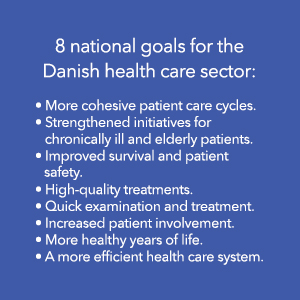 The Danish government wants to increase the quality of health care treatments by measuring 25 selected indicators based on eight national values within health care. The purpose is to make it easier for local health care professionals to improve the quality of their work.
The Danish government wants to increase the quality of health care treatments by measuring 25 selected indicators based on eight national values within health care. The purpose is to make it easier for local health care professionals to improve the quality of their work.
In 2016 the Danish government introduced eight national goals for the Danish health care sector. The purpose was to secure better treatment for all patients and make it possible for health care professionals to implement local solutions to improve health care quality. Working with the indicators will maintain a focus on positive advantages for patients.
The health care sector has the attention of politicians and administrators because costs in the sector are increasing and, in some situations, patients’ lives are at risk. So it is important for the sector to measure its progress and report results.
From my point of view, it is important that the health care sector knows the possibilities of modern technology to understand how much it can contribute. To succeed at being transparent and well-documented in all 25 indicators, without getting a lot of unnecessary administrative workload, you need to know what is possible. This is what this article is about.
The 25 selected indicators focus on the overall goals and an annual status report, which assesses the indicator documents and shows whether the health sector is moving in the right direction or not. To succeed, local reporting is required, as well as being able to collect data and act on it.
The existing framework, called Nordic Clinical Analytics Framework (NCAF), can make this happen automatically. The same applies to other audits based on prioritised quality indicators. The significance of this is that audits do not have to take patient time from health care professionals.
The significance of automatic audits is that it does not have to take patient time from #HealthCare professionals. #Analytics Click To TweetThe goals of the NCAF solution are to:
- Minimise manual processes.
- Go from sampling to using 100 percent data.
- Enable health care professionals to use data proactively.
- Enable health care professionals to report and use real-time data.
- Conduct audits and follow up when needed.
- Get the chance to observe the effect of specific quality initiatives.
- Make audit results available through a web portal.
How it works
The solution includes all patient journals. The quality work is no longer based on samplings, but on the full population. This allows more focused action plans and the opportunity to respond immediately on “red” indicators. A red indicator could show a problem in a certain department, or be related to a single person – for example, a health care professional who often forgets to register medicine in the discharge summary.

The NCAF solution for automated journal audit for selected quality indicators gives more benefits overall. It provides an overview that ensures health care professionals can spend their time acting on the analysis results instead of collecting and choosing data, working through manual audits, and analysing and presenting results in certain charts.
This means that the focus can be on future actions based on analysis. Moreover, the solution offers a quick overview of the development of each indicator over time.
The audit solution can be expanded with a module that handles quality initiatives in the form of a link to document creation, a link to existing quality documents, built-in alarms for follow-up initiatives, and marking the start and end time. These features make it easy to measure the effect of initiatives.
Audits of patient journals to improve quality measured by certain indicators do not have to take up patient time. With the right solution, analytics will quickly add value to the treatment of patients and fulfil the purpose of the eight national values for high health care quality.
Read more about how to become a data-driven organisation. Download this eBook.
For more information or a presentation of the NCAF solution, please contact: MortenKrogh.Danielsen@sas.com
